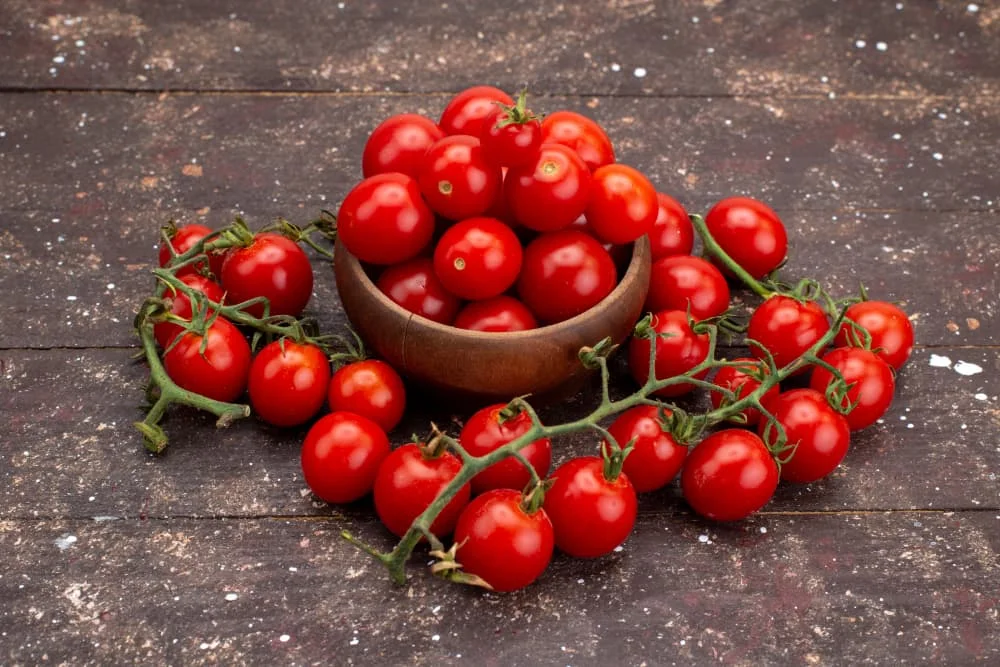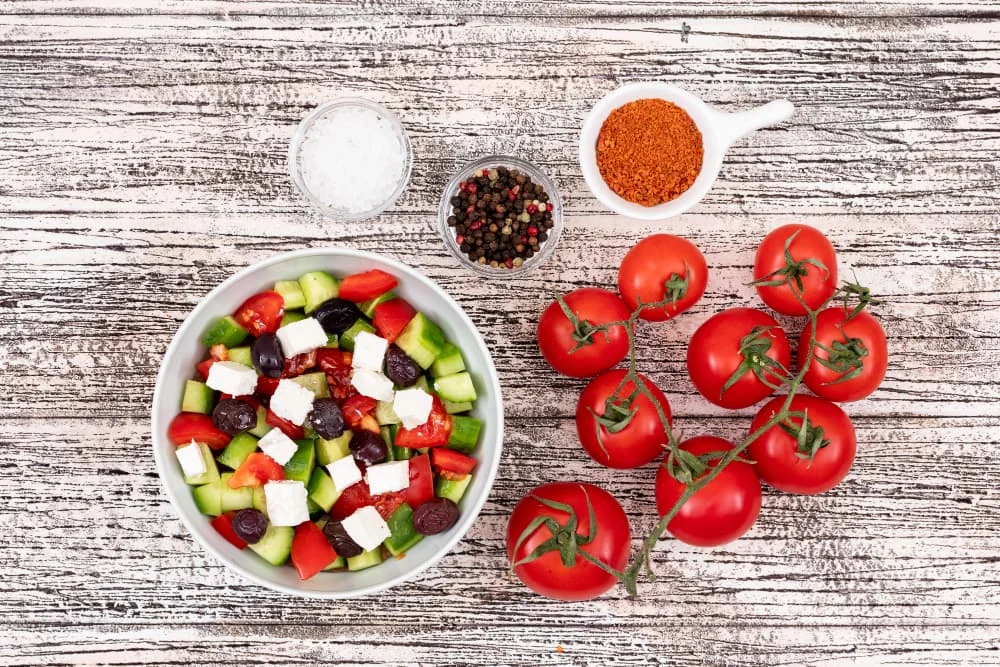Cherry tomato nutrition is impressive, making these small fruits celebrated not only for their naturally sweet flavor and juicy texture but also for their outstanding nutritional value. These small fruits aren’t just a delightful snack, they pack a robust dose of essential vitamins, minerals, and antioxidants that contribute to overall health. We take an in-depth look at the nutritional benefits of cherry tomatoes, explaining why they truly deserve the title of superfood. We also offer creative ideas on how to seamlessly incorporate these versatile tomatoes into your daily meals.
What are Cherry Tomatoes?
Cherry tomatoes are a small variety of tomato celebrated for their naturally sweet flavor and juicy texture. They are typically about the size of a cherry and are mostly round, although some may be slightly oblong like grape tomatoes. Their convenient size and burst of flavor make them an ideal choice for salads, snacks, and many other dishes.
For those who are mindful of their diet, it is important to note that the cherry tomato calorie count is very low, making these fruits a guilt-free addition to your meals. They come in various colors, including classic red, yellow, orange, green, and even black, with each type offering subtle differences in taste.

Cherry Tomato Nutrition Info
Tomatoes are more than just a delightful addition to your meals; they are a concentrated source of essential nutrients that offer a range of health benefits. Below, we explore the nutritional profile of these vibrant little gems.
Here is an overview of the key nutrients found in a 100-gram serving (about 2/3 cup) of cherry tomatoes:
| Nutrient | Amount | % Daily Value (DV) |
| Calories | 18 | 1% |
| Carbohydrates | 3.9g | 1% |
| Fiber | 1.2g | 5% |
| Protein | 0.9g | 2% |
| Fat | 0.2g | 0% |
| Vitamin A | 833 IU | 17% |
| Vitamin C | 13mg | 22% |
| Potassium | 237mg | 7% |
| Lycopene | 2573 mcg | * |
| Folate | 15mcg | 4% |
| Vitamin K | 7.9mcg | 7% |
(Source: USDA FoodData Central. Note: Values may vary slightly depending on the specific variety and growing conditions.)
Nutrition Facts
With their impressive profile, cherry tomato nutrition plays a big part in what makes them such an excellent choice for those seeking a nutrient-rich, low-calorie food. Here are some of the key benefits they offer:
- Low in Calories: If you’re watching your intake, you’ll be pleased with the cherry tomato calorie count – only about 18 per 100g serving, and roughly 27 calories per cup. This makes them a smart option for weight management.
- Rich in Vitamin C: This antioxidant supports your immune system and aids in collagen production for healthy skin.
- Good Source of Vitamin A: Essential for maintaining good vision and supporting cell growth.
- Contains Potassium: This mineral helps regulate fluid balance and maintain healthy blood pressure.
- High in Lycopene: The antioxidant responsible for their red color, lycopene, has been linked to a reduced risk of chronic diseases.
- Additional Nutrients: Also provide smaller amounts of folate, vitamin K, and B vitamins, contributing to overall well-being.
In summary, incorporating them into your diet is a delicious way to boost your intake of essential vitamins, minerals, and antioxidants, making them a true nutritional powerhouse.
Health Benefits of Cherry Tomatoes
Cherry tomatoes are much more than a flavorful addition to your meals. Their impressive nutritional profile offers a variety of health benefits that can contribute significantly to your overall well-being.

1. A Powerhouse of Antioxidants for Disease Protection
Cherry tomatoes are rich in antioxidants, notably the powerful carotenoid lycopene that gives them their vibrant red hue. These antioxidants help combat oxidative stress—a harmful imbalance between free radicals and protective antioxidants in your body. Oxidative stress is linked to chronic diseases such as cancer, diabetes, heart disease and kidney disease.
The impressive cherry tomato nutrition profile, specifically the high antioxidant content, is what makes them stand out. Research suggests that lycopene may reduce the risk of certain cancers, including prostate and breast cancer, while also protecting against heart disease. Additionally, they contain flavonoids like naringin and naringenin, which have been studied for their antioxidant and anti-inflammatory properties.
2. Supporting Heart Health
The nutrients in cherry tomatoes support heart health in several ways. Lycopene has been shown to improve blood vessel function, which is essential for maintaining healthy blood flow. Studies indicate that it may also help lower LDL (“bad”) cholesterol levels and affect the way your body processes cholesterol and stores fat.
Low levels of lycopene in the blood have been linked to an increased risk of heart attack and stroke. Moreover, compounds such as chlorogenic acid can assist in regulating fat metabolism, while the potassium in them helps maintain healthy blood pressure—especially important when replacing high-sodium foods.
3. Potential Anticancer Properties
Although more research is needed, the high concentration of lycopene in cherry tomatoes shows promise in the fight against certain cancers. Studies have found that a higher intake of tomatoes, including cherry, is associated with a modest reduction in the risk of prostate cancer. There is also some evidence suggesting that elevated blood levels of beta-carotene—a carotenoid present in tomatoes—may lower the risk of breast cancer.
4. Promoting Healthy Skin
As we age, our skin faces challenges from factors like ultraviolet (UV) exposure. Nutrients in cherry tomatoes, such as lycopene, polyphenols, and other antioxidants, play a crucial role in protecting the skin from UV damage. These compounds help improve skin hydration and may slow down visible signs of aging, supporting a healthier, more resilient complexion.
5. Other Benefits
In addition to the benefits discussed above, they offer further advantages:
- Vitamin C supports a robust immune system.
- Vitamin A is vital for maintaining healthy vision.
- Their fiber content aids in digestion and can assist with weight management.
Important Note: While these potential benefits are promising, it’s important to remember that balanced diet is only one component of overall health. Enjoying them as part of a varied and nutritious diet can help you reap their many rewards. It’s clear that cherry tomato nutrition plays a valuable role in a healthy diet.

Ways to Enjoy Cherry Tomatoes
Cherry tomatoes are incredibly versatile in the kitchen, offering a burst of flavor and nutrition that can elevate many dishes. Their small size and natural sweetness make them an ideal ingredient for a wide variety of recipes. Here are some simple yet delicious ideas to incorporate them into your meals:
- Salads: For a burst of color, juicy sweetness, and very few calories, add these to your favorite salads. Knowing the low cherry tomato calorie count makes this addition guilt-free! Whether you toss them whole or cut them in half, they blend well with mixed greens or can be paired with fresh mozzarella for a classic tomato salad.
- Pasta Dishes: Roast them with garlic and herbs to create a flavorful pasta sauce or stir them into a pasta salad for a refreshing twist that brightens up the dish.
- Sandwiches and Wraps: Enhance your sandwiches, wraps, or burgers with sliced tomatoes. They add a juicy texture and extra flavor that can transform a simple meal into something special.
- Snacking: Enjoy cherry tomatoes on their own as a healthy, on-the-go snack. Their convenient size makes them perfect for a quick bite during a busy day.
- Roasted: Roasting tomatoes intensifies their sweetness and creates a richer, more concentrated flavor, while also increasing the bioavailability of lycopene, a key component of cherry tomato nutrition. Simply toss them with olive oil, herbs, and garlic, then roast until tender. They make a great side dish or a delightful addition to roasted chicken or fish.
- Sauces and Dips: Use them as a base for quick pasta sauces or blend them into dips and salsas. Their natural flavor can enhance any sauce, adding both depth and brightness.
The possibilities are endless. Experiment with these ideas and discover new, exciting ways to enjoy the delicious flavor and nutritional benefits of cherry tomatoes. Their versatility in the kitchen makes them as practical as they are flavorful.
How many calories are in cherry tomatoes?
A 100-gram serving of cherry tomatoes (about 2/3 of a cup) contains approximately 18 calories. A full cup is about 27 calories. The exact cherry tomato calorie count can vary slightly depending on the specific variety and growing conditions, but they remain a low-calorie food overall.
How Should I Store Them?
Store tomatoes at room temperature in a cool, dry place away from direct sunlight. Keeping them out of the refrigerator helps preserve their flavor and texture. They generally stay fresh for about a week when stored properly. If you must refrigerate them, try to use them within a few days.
What Is the Best Season for Them?
Although you can find them year-round in most markets, cherry tomatoes are at their best during the summer months. During this time, they are at their sweetest and juiciest, often sourced locally for peak flavor.
Are They Healthier Raw or Cooked?
Both raw and cooked tomatoes offer health benefits. Eating them raw preserves more vitamin C, while cooking increases the bioavailability of lycopene, a powerful antioxidant. A balanced diet that includes both forms is ideal.
Can I Freeze Them?
Yes, you can freeze tomatoes. Wash and dry them thoroughly, then spread them in a single layer on a baking sheet until frozen. Transfer the frozen tomatoes to a freezer bag. Note that frozen tomatoes are best used in cooked dishes like sauces or stews, where their texture is less critical.
Are They a Fruit or a Vegetable?
Botanically, tomatoes are fruits because they develop from the flower’s ovary and contain seeds. However, in culinary terms, they are typically treated as vegetables.
How Do I Select Ripe Ones?
When choosing tomatoes, look for fruits that are brightly colored and firm to the touch. Their skin should be smooth and taut. Avoid tomatoes that are wrinkled or overly soft, as these may be overripe.






